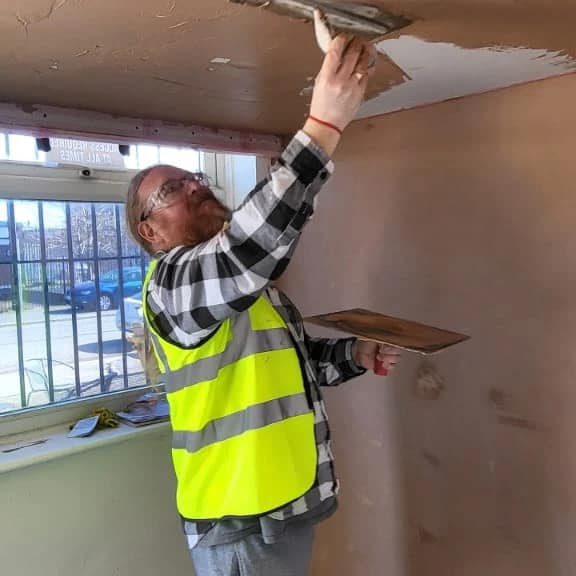Plastering Made Simple: Step-by-Step Overview for Beginners
Recognizing the Essential Techniques of Smudging for Home Enhancement Projects
In the realm of home enhancement, mastering the essential strategies of plastering can significantly improve both the performance and visual appeal of an area. Different methods exist, each customized to details applications, whether for bring back historical integrity or modernizing interiors. The plastering procedure encompasses essential stages, from thorough surface area preparation to the accurate application of materials. Comprehending these fundamental components is crucial, yet many house owners neglect common challenges that can undermine their initiatives. As we discover these methods further, the subtleties of accomplishing a perfect coating will come to be significantly evident.
Kinds Of Smudging Methods
Although different gluing methods exist, each serves an unique function and provides distinct aesthetic qualities. Among the most typical techniques is traditional lime plastering, which is recognized for its breathability and adaptability. This method is specifically valuable for older frameworks, allowing wetness to escape while maintaining structural stability.
For an extra distinctive look, trowel-on plastering techniques such as stucco and Venetian plaster are frequently utilized. Stucco, generally used in exteriors, provides resilience and weather condition resistance, while Venetian plaster is renowned for its elegant, polished finish.
Additionally, there are much more specialized strategies, such as skimming, which is a process that entails using a slim layer of plaster over existing surface areas to create a smooth finish. Each of these strategies can substantially affect the total aesthetic and functionality of a space, making it vital to select the ideal approach based on the certain demands of a job.

Devices and Products Needed

The hawk offers as a system to hold the plaster, while the trowels, offered in various sizes, are vital for application and smoothing. A float, typically made of rubber or sponge, is utilized to achieve a consistent coating.

Safety gear can not be neglected; security safety glasses, handwear covers, and masks are essential to protect against dust and debris. Ultimately, a tough ladder may be required for reaching greater locations, making certain safety while operating at height. Investing in top quality tools and products eventually adds to a more effective gluing project, yielding a long lasting and cosmetically pleasing coating. Appropriately furnished, you lay the groundwork for effective plastering and home improvement.
Step-by-Step Plastering Process
With the right devices and materials in hand, the following stage includes executing the smudging process with accuracy. Begin by preparing the surface to guarantee optimal bond. Remove any type of loosened debris, dust, or old plaster, and apply a bonding representative if essential.
Once the surface is prepped, blend the plaster according to the their website manufacturer's directions, achieving a smooth, lump-free uniformity. Using a trowel, apply the very first coat, called the scrape layer, to a density of regarding 5-10 mm. Ensure uniform coverage, and make use of a comb or scratcher to create grooves for better bond of succeeding layers.
After permitting the scratch layer to establish partly, apply the second coat, or the brown layer, smoothing it out for an even surface. Use the ending up layer, which need to be thinner and smoother.
Once the plaster has dried completely, it can be fined sand gently to remove imperfections. Comply with up with a guide prior to painting for a refined last appearance.
Common Blunders to Avoid
Stopping working to acknowledge typical blunders can considerably influence the top quality of your plastering task. One constant mistake is inadequate surface preparation. Stopping working to clean and prime the surface can cause inadequate adhesion, leading to fractures and peeling off. Moreover, neglecting to repair any underlying problems, such as moisture or structural damages, can jeopardize the plaster's stability.

Timing is likewise essential; many unskilled plasterers hurry the application. Enabling the initial layer to dry entirely prior to applying subsequent layers is important to prevent too much fracturing and contraction.
In enhancement, not utilizing the right tools can hinder the finishing procedure. Utilizing trowels that are as well large or little can impact your control and the level of smoothness of the coating.
Tips for Finishing Touches
Accomplishing a perfect finish in plastering calls for focus to detail and a couple of strategic methods. Once the preliminary application has actually dried, start the finishing procedure by using a moist sponge or trowel to smooth out any kind of imperfections. This action not just enhances the surface however also assists to get rid of any excess plaster that may have dried erratically.
Following, take into consideration using a fine-grit sanding block or pole sander for an extra sleek look. Fining sand ought to be done carefully to stay clear of damaging the underlying layer - Plastering. Always put on a mask my latest blog post to protect against dirt breathing
After sanding, examine the surface under various illumination conditions to determine any type of missed out on more helpful hints places or variances. Apply a thin layer of finishing plaster if needed, feathering out the sides to mix seamlessly with the surrounding area.
Final Thought
In final thought, understanding essential plastering techniques considerably boosts the high quality of home enhancement jobs. Recognizing the numerous kinds of gluing techniques, using suitable tools and products, and adhering to a systematic application process contribute to achieving a sturdy and smooth surface.
In the realm of home enhancement, mastering the necessary methods of plastering can substantially improve both the capability and aesthetic charm of a space.Although different smudging strategies exist, each serves an unique function and supplies distinct aesthetic qualities. Plastering. For an extra distinctive appearance, trowel-on plastering methods such as stucco and Venetian plaster are often utilized. Stucco, generally used in exteriors, supplies resilience and weather condition resistance, while Venetian plaster is renowned for its elegant, refined surface
Commonly used plaster types consist of gypsum plaster, lime plaster, and cement-based plaster, each offering different purposes and atmospheres.